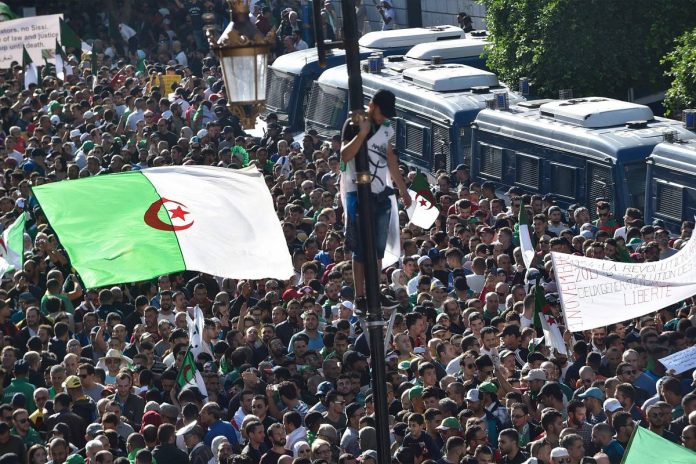Burkina Vista Social Club: Afro-Cuban music in the midst of musical and political nostalgia
October 17 2019 | 10:04
A band playing Cuban rhythms in Ouagadougou, September 15 2019 | AFP/Archives
Cuba, Burkina, Sankara, Ouaga, rumba, salsa, cha-cha-cha: Cuban music rhymes with Africa, and in Ouagadougou, Afro-Cuban music is successful in an atmosphere of nostalgia and politics.
Sports Bar, Mezzanine, Kaseto Rimnoma... many bars in Ouagadougou program live orchestras that play Afro-Cuban music for fans often aged 60–70 years or more but still alive on the dance floor. There are some young people but they are rather an exception.
With his Borsalino hat and dark glasses, the bass player plays a Cuban rhythm together with a 65-year-old guitar player who plays without seeming to touch the strings.
At the Boulougou bar, founded in 1952, one would think they are seeing a reformation of the mythical Buena Vista Social Club, which jumped to stardom in the 90s after years of oblivion and when its virtuous members (Compay Segundo, Ibrahim Ferrer, Manuel Mirabal) were already grandfathers. They are Les Elites du Faso, a band from Burkina Faso, composed of musicians who were young at the time of the Cuban Revolution.
"The Burkinabé like Cuban music because it reminds them of the old times, the times of our fathers and our former president Thomas Sankara, who also loved Cuban music", says singer Bobo Seydou, born in 1965.
"Revolutionaries"
Cuban music owes part of its success to Cuba's soft-power politics at the time of the struggles for independence and the anti-imperialist leaders that followed.
Among them was Thomas Sankara, nicknamed the "African Che", who chaired Burkina from 1983 until his assassination in 1987. A Pan-Africanist and anti-imperialist, Sankara — who lived a modest life — tried to eliminate corruption and put focus on education and health while supporting agriculture. His Committees for the Defense of the Revolution (CDR), responsible for controlling the population with an iron fist, were the dark side of his regime.
Under Sankara, many Burkinabé went to study in Cuba. Conversely, if Cuba sent political, military, and medical advisers to Africa, the island also had orchestras there, such as the famous Orquesta Aragón.
The private lives of Les Elites du Faso members also tell this story.
Musicians from the band Les Elites du Faso perform on stage in Ouagadougou, Burkina Faso, September 15, 2019 | AFP
Bobo Seydou is not from Burkina Faso but from Guinea-Bissau where they had "25 years of war for liberation" (1974). "It was the Cubans who provided us with weapons" as well as military instructors against the Portuguese, he said, pointing out that "Amílcar Cabral (murdered in 1973) and Thomas Sankara (murdered in 1987) were revolutionaries".
"At that time, I was in the military. I left the barracks at night to play at funerals, weddings, baptisms. Cuban music was in fashion...", he says. He keeps from this time a finger mutilated by a shooting accident.
In 1978, with his group Africa Ritmo, he left Guinea-Bissau looking for "adventure". "We were young, we left. We dreamed of Europe. We played Cuban music", he recalls. He randomly arrived in Burkina Faso in 1978 and hasn't left since.
Five years later, Sankara takes power. "I played at the CDR conference. We played with him. He loved music. He liked both Cuban and Congolese music", says Bobo.
Orchestre Missile
At that time his band often played at a bar everyone remembers: Don Camilo. "We played everything but also Cuban music or Cuban-inspired personal compositions. Cuban doctors would come to dance".
Portrait of former president Thomas Sankara, killed in October 1987, in Ouagadougou, Burkina Faso, March 3, 2019 | AFP/Archives
Those were wonderful times for musicians. "Sankara lowered the price of drinks and favored live bands. He did not like nightclubs. People were coming out. We were doing great at that time", he says.
Today, although nightclubs are slowly taking over live music, Ouagadougou remains a musical capital with a scene still alive. Music and politics remain linked, since 2014 uprising that overthrew Blaise Compaoré was the work of many young people who called themselves Sankarists and listened to rap and reggae.
The guitar player, Roger Bihoun, 65 years old, can brag about having been a part of the same band as Sankara, who was also a nice guitar player: the Orchestre Missile. "At the time he was an officer. Before being president. He sang and played well. He knew music quite well, although he was not a virtuoso", says Bihoun, who claims to have given Sankara advice on the guitar. "He later had less time to play, but he kept doing it during his presidency".
The revolutions are over but on the dance floor, Ousseny Lamizana, retired and 67 years old, a master of all dance steps, turns young again. "We're having a blast", he says, sitting next to a cold beer. For him, Cuba and Africa are inseparable.
"There is a lot of African culture in Cuban music, rhythm and percussion, of course: salsa comes from Cuba but is African! Rumba is African!!!".
Burkina Vista Social Club: Afro-Cuban music in the midst of musical and political nostalgia








